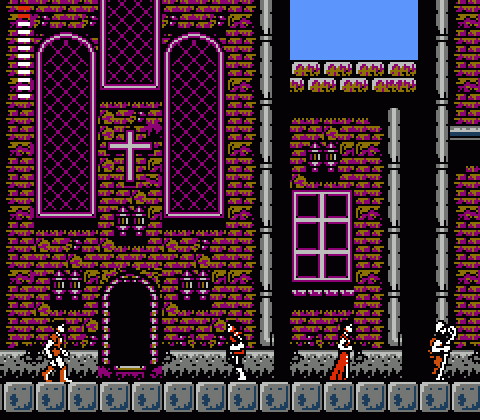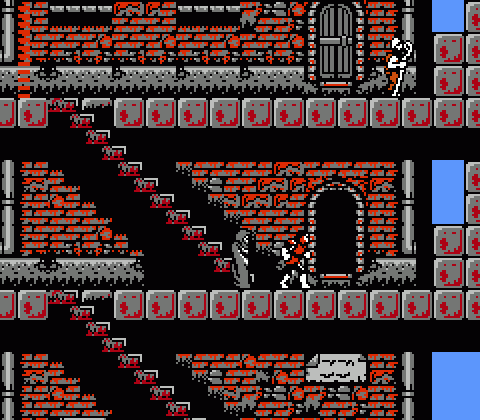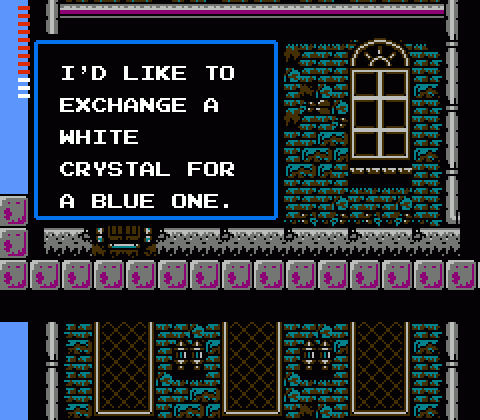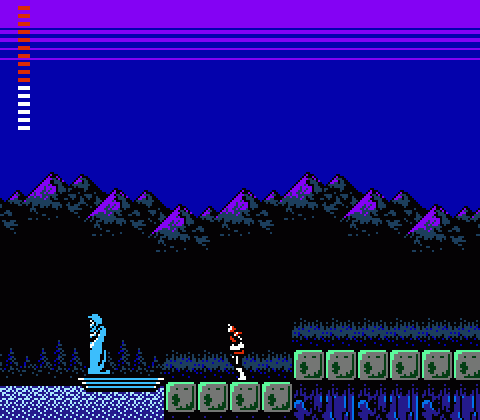Let’s talk about Simon’s Quest‘s NPCs.

Long story short, Transylvania is populated by a bunch of jerks. I get that living in the shadow of a cyclical undead horror bent on conquering the world by transforming humanity into a race of snack-pack slaves can be pretty harrowing, but that’s exactly why you’d assume these guys would be a little friendlier to the one man who can save them from becoming ambulatory juice boxes. But no; something like half the NPCs in the game are either actively hostile toward Simon or simply lie to him.
I always assumed the game’s wildly inaccurate hints came from the 8-bit tradition of terrible localization, but it turns out these guys are a bunch of liars in Japanese, too. I once asked former Castlevania series producer Koji Igarashi about the possibility of him creating a game in the spirit of Simon’s Quest, with NPCs to talk to and hints to gather, and his response was a mildly befuddled, “But all of those guys lied to you!” So evidently the game’s writers were just being mean.
The idea of unreliable in-game characters isn’t a bad one, but it doesn’t work out as well here as I think the designers intended. The problem? Castlevania II doesn’t offer enough detail and clarity to help you effectively sort out truth from fiction. While it’s all well and good for someone to tell you that you should hit your head against Deborah Cliff to make a hole to mislead you, that tip would be more obviously ridiculous if not for the fact that the real solution — kneeling in front of the cliff with a Red Crystal equipped for five seconds — is no less arcane or ridiculous. Simon’s Quest employs too much 8-bit logic to give deliberately misleading tips; rather than shake your head ruefully once you figure it out, you’re far more likely to shake your fist in annoyance because the real solution is equally dumb.

By and large, you can safely ignore any brown NPC. That’s not racism! I just mean the villagers who offer primarily lies and useless remarks wear clothes in an earth-tone palette. The brown-clad folks who don’t actively mislead you mostly offer empty pleasantries that burn through your clock time.
On the other hand, NPCs in other color schemes — grey and blue, primarily — offer beneficial advice and items. In most cases, you need to shell out precious money for their help, but others will simply give you things. One dude begs you to take 50 hearts’ worth of Laurels for free. Another will turn your Morning Star into the almighty Flame Whip. A couple of tall, grey guys scattered throughout the game allow you to trade up your crystals to solve the next puzzle in the chain of progression.

Others function as riddles in themselves, like the ferryman. Talk to him normally and he cackles and takes you to one area (including a town where you can buy the Morning Star, which is right decent of him). Talk to him while holding Dracula’s Heart and he takes you to the third Mansion. I suppose if a crazed-looking man came up to me with a bloody heart in his hands and demanded a ride, I’d take him wherever he wanted to go, too.

A lot of the game’s lies can be worked through with patience and trial-and-error. I played this game enough as a kid that I tried out pretty much everything. For instance, the guy who tells you the ferryman likes garlic? If you try to use garlic while on the boat, it falls through into the river. If you drop it on the shore, nothing happens besides you having wasted 50 hearts. And others are just amusing; I always liked the lady who promises Simon a midnight rendezvous on the riverbank. Go to the river at midnight and she’s nowhere to be seen. Turns out she was just giving him the brush-off, the medieval equivalent of giving him the wrong phone number.
In the later towns of the game, the tone of NPCs becomes more directly hostile (including demands to straight-up get the heck out of Dodge). The introduction to Dracula’s Curse expands on this, describing in detail how the people of Transylvania distrust the holy powers of the Belmont family almost as much as they fear Dracula, and that the clan forever lives as pariahs in the land they protect. It’s a nice bit of world-building that begins here.
Still, you want to find the Graveyard Duck, you’ll need to look elsewhere.
Yeah, that’s the thing, really. The actual solutions to many of Castlevania II’s puzzles that the nicer villagers will share are often just as batshit insane as the blatant lies the asshole NPCs will tell you.
Speaking of lies, this is off topic a bit, and will make no sense unless you’ve played Viva Piñata, but I swear Leafos is at least partially related to those lying NPCs. Much like CV2, Viva Piñata has outright crazy quota to meet (in its case, for piñata appearances, visits, residents, romancing, and evolutions), and if you try talking to Leafos now and then, she has no problem feeding you lies like a Dragonache appearing if you become a Dragumfly Master Romancer or a Cluckles becoming a Parrybo if it eats five different colored flowers.
But of course, sometimes she’s telling the truth, like with Cocoadiles watering plants with their tears, and somewhat with the Sour Crowla getting sick and you calling the doctor (letting it drink medicine is a requirement to convert it). In-game logic, huh?
I think many kids-like myself at the time-simply assumed that there was some inscrutable logic at work which we were not worthy to comprehend. I would read stuff in pilfered or borrowed issues of Nintendo Power that gave me the impression that there was some cryptic cabal of hooded patriarchs ruling the game industry who devised the bizarre logic underlying our favorite 8-bit titles and whose word was law.
Air Shooter defeats Crash Man? Sure!
Pressing a secret combination of buttons and directions give you extra lives in Contra? Of course!
Kneel for five seconds with a red crystal equipped to summon a mystic cyclone? Why the heck not?
In other words, I just felt like EVERYTHING at the time was either trial and error, or governed by such insane mirror-universe logic as to make no practical difference. It was the games that were RATIONAL that blew my mind.
“but that’s exactly why you’d assume these guys would be a little friendlier to the one man who can save them from becoming ambulatory juice boxes.”
Isn’t this right here the thing though? Simon Belmont is not the one man who is going to save them, he is the one man who is going to resurrect Dracula. To these townspeople he’s probably a raving lunatic intent on adorning himself with Dracula’s bodyparts.
I mean, it obviously doesn’t work from the player’s perspective, but it seems to me these people have good reason to prevent Simon from questing.
That… is actually very correct. Huh.
I had no idea the veracity of townfolk in this game was generally correlated with sprite color. That’s surprisingly helpful.
@Kirin It’s not that cut-and-dried. The grey guys are always merchants or quest chain participants, and the oddly colored cloaked guys throughout the world perform various tasks for you, but everyone else wears brown and may or may not be telling the truth.
@Kirin
It’s not so much veracity, just that the brown ones don’t do anything except speak to you. The other colors all affect the game in some way, selling stuff/swapping crystals etc.